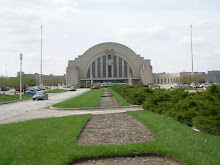Walnut Hills Month Edition!
The San Marco Apartment Building at 1601 Madison Road occupies a prominent spot at the southeast corner of Madison Road and Woodburn Avenue at the heart of the DeSales Corner in East Walnut Hills. This was the heart of the historic Village of Woodburn which was incorporated in 1866 but not long after annexed to Cincinnati in 1873. The San Marco Apartment Building is now, along with other neighborhood buildings, in the Woodburn & Madison Local Historic District. Many of the buildings in the business district are unique in that they were built specifically to cater to the German immigrants and parishioners of nearby St. Francis DeSales Catholic Church, completed in 1879.
The San Marco was designed by prominent, local architects John Boll and Charles Taylor and completed in 1893. The design is eclectic. Walter Langsam describes the style of the building as Richardsonian but seems to combine elements of Queen Anne, Chateauesque and Richardsonian Romanesque architecture. All of those styles were contemporary of each other and the building combines for instance roman arches, grouped colonnettes, and fanciful stone carvings.
Victorians in America suspected that apartment buildings “fostered an unhealthy moral climate”. It was not considered respectable for men and women from different families to live in the same building and only those who could not afford otherwise lived in multi-family buildings. Thus the apartment building was seen as “potentially dangerous to family life”. However by the 1890’s these prejudices towards apartment living for the middle and upper class abated and more began to appear across the United States.
The San Marco Apartment Building was built in this wave of upscale apartment construction in America and specifically Walnut Hills from the 1890’s through the turn of the century. Other luxury Walnut Hills apartments include The Verona (1900), The Alexandria (1904), The Navarre (c. 1905), and The Clermont (1907) all designed by Joseph Steinkamp & Brother and built by Thomas Emery & Sons. Other apartment buildings also include The Haydock (1903, now The Grandview) in East Walnut Hills and The Trevarren Building (c. 1895), The Hauck Building (c. 1895) and The Ransley (1895) all near Peebles Corner. The latter building was designed by the prominent architecture firm Samuel Hannaford & Sons.
An early advertisement reprinted in the Woodburn Avenue NBD Historic District Designation Report:
“The San Marco Apartment Building is located on the South-East corner of Woodburn and Madisonville Avenues, East Walnut Hills, City; twenty minutes ride on cable or electric cars from Fifth and Walnut Streets. The building is constructed of brick, with handsome carved stone trimmings. There are three flats on each floor, containing five rooms each, private halls, bath rooms fitted up with white marble floors and wainscoting, enameled tub, stationary wash-stand, open plumbing, nickel plated pipes; kitchen and gas range for same, butler’s pantry, dining room, two chambers, and parlor; each flat is provided with one room on top floor for servant. Speaking tubes and electric bells connected with same.”
Architects Boll and Taylor practiced architecture as a firm from about 1889 – 1907. Boll continued work on his own until near the time of his death in 1941. Boll was from Cincinnati and studied architecture with George W. Rapp. Taylor went to OMI and worked for William Aiken and Alfred Elzner before his partnership with Boll. Taylor eventually partnered briefly with Benjamin DeCamp. Boll and Taylor designed a number of buildings including diverse building types such as private residences, schools, churches, and large commercial buildings and factories. Their work includes for instance a number of buildings in Addyston, OH for the Addyston Company including factory buildings and a hotel. All of Boll and Taylor’s surviving buildings in Addyston are on the National Register of Historic Places. The most well known Boll & Taylor building is probably the Carnegie Library in Covington (1904).
Today, the San Marco is managed by CMHA as senior housing. It offers thirty, one bedroom apartments in one of CMHA’s smaller senior communities.
So while many of the grand apartment buildings of Walnut Hills could be considered for “Crown Jewel” status, I hope you agree with me that the San Marco is indeed special and worthy of recognition.
'Walnut Hills Month' is a multi-part series documenting Walnut Hills and ending with the ARCHITREKS walking tours of Walnut Hills on August 29 and 30.
References:
Langsam, Walter. Biographical Dictionary of Cincinnati Architects, 1788 – 1940. Architectural Foundation of Cincinnati: Cincinnati, OH. 2008
Federal Writers Project. Cincinnati, A Guide to the Queen City and Its Neighbors. City of Cincinnati, Cincinnati, OH. 1943
Woodburn Avenue NBD Historic District Designation Report
East Walnut Hills Assembly Historic Preservation Inventory, 1995
Historic image from Library’s Cincinnati Memory Project
.jpg)

No comments:
Post a Comment